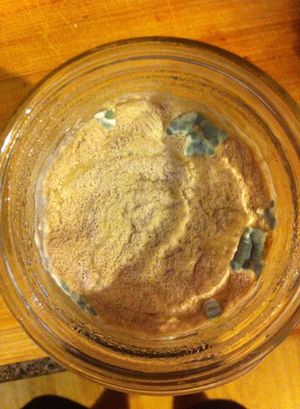Difference between revisions of "Commercial Beer Dregs Inoculation"
| Line 16: | Line 16: | ||
* Many commercial sour beers are bottle conditioned with fresh wine or champagne yeast. If this yeast is still viable, it may contribute to the fermentation profile. If this is a concern, cooling the beer and leaving the sediment behind may help to alleviate the problem, however at least some the wine/champagne yeast will probably still be in suspension in the beer. The long term survival of many strains of Saccharomyces yeast is usually limited in a low pH sour beer. | * Many commercial sour beers are bottle conditioned with fresh wine or champagne yeast. If this yeast is still viable, it may contribute to the fermentation profile. If this is a concern, cooling the beer and leaving the sediment behind may help to alleviate the problem, however at least some the wine/champagne yeast will probably still be in suspension in the beer. The long term survival of many strains of Saccharomyces yeast is usually limited in a low pH sour beer. | ||
* Mold growth, although rare, is a possibility. If mold begins to grow, throw out all of the beer and start over. | * Mold growth, although rare, is a possibility. If mold begins to grow, throw out all of the beer and start over. | ||
| − | + | [[File:Mold dregs.jpg|thumbnail|left|([https://www.facebook.com/photo.php?fbid=1590340977863716&set=gm.1006273332734214&type=1&theater Starter made from bottle dregs from Monte Subite Geuze.] The green colored stuff is mold.)]] | |
==References== | ==References== | ||
Revision as of 12:05, 1 April 2015
Beer or wort can be inoculated with commercial sour beer that is not pasteurized. Generally, only the last half inch of a bottle's contents, including the sediment, is used. This portion of the beer is often referred to as "the bottle dregs". It is recommended that the microbes in this beer are first reinvigorated with a small starter wort of around 1.030 gravity before it is added to the fermentation vessel. Using commercial sour beers to ferment is generally a good idea because the microbes are often stronger and more aggressive from commercial breweries as compared to mixed cultures from yeast companies (this is a generalization). It is generally advised to use as fresh of a bottle of commercial sour beer as possible, however older bottles can be used as well depending on the brewery, beer, and how the bottle was stored.
Contents
General Methods and Uses
Creating a starter
A regular strength starter of a volume of 2-3 cups should be prepared for the bottle dregs. The starter is prepared as normal. If the brewer has only one bottle or wants to keep multiple bottle dregs separate from each other, the starter wort can be poured directly into each bottle and covered with aluminum foil or plastic wrap. Alternatively, the dregs from multiple bottles can be combined into a single vessel (such as a glass jug) with the starter wort, and covered with aluminum foil or plastic wrap. The starter should be stored at room temperature, or can be stored at a higher temperature if bacteria is the main microbe that the brewer is after. The mouth of the bottle may be flamed with a lighter to kill any wild yeasts that might have landed on the area. Keep the starter for at least one week, and monitor for activity. Visual activity may not always be present, but monitoring the pH and the gravity can assist the brewer with deciding whether or not the commercial sour beer has any viable microorganisms still alive in it.
Supplementing another fermentation
Once the starter of the bottle dregs has sufficiently incubated, it can be pitched into another sour beer. The idea here is that the strong microbes from the commercial sour beer can enhance the overall complexity of the beer, especially if the beer's only other inoculation was from a culture from a yeast company.
Using as a primary fermenter
Bottle dregs can also be used a primary fermenter. It is generally advised that mixing different bottle dregs together will provide a greater diversity and thus better results, but using a single bottle may prove to be an educational experience as well. Jeffrey Crane describes a method of using 1 gallon of wort, which can easily be produced on a normal brew day from a larger batch, to create sour beer from bottle dregs. Essentially this process involves transferring 1 gallon of at wort any time during the boil when there are less than 7-10 IBU's. That 1 gallon of wort is then used to pitch the sour beer dregs starter into.[1] The brewer has the option of allowing the 1 gallon of sour beer to age on it's own, or it can be used as a starter itself for a larger batch.
List of Unpasteurized Commercial Sour Beers
A comprehensive and well maintained list of unpasteurized commercial sour beers can be found on Michael Tonsmeire's blog, The Mad Fermentationist[2].
Potential Problems and Issues
- Many commercial sour beers are bottle conditioned with fresh wine or champagne yeast. If this yeast is still viable, it may contribute to the fermentation profile. If this is a concern, cooling the beer and leaving the sediment behind may help to alleviate the problem, however at least some the wine/champagne yeast will probably still be in suspension in the beer. The long term survival of many strains of Saccharomyces yeast is usually limited in a low pH sour beer.
- Mold growth, although rare, is a possibility. If mold begins to grow, throw out all of the beer and start over.

References
- ↑ Jeffrey Crane describes how to make 1 gallon sour beers from bottle dregs.
- ↑ Michael Tonsmeire's list of unpasteurized commercial sour beers.